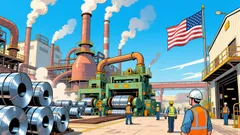AInvest Newsletter
Daily stocks & crypto headlines, free to your inbox
Tesla’s Q1 2025 earnings call painted a picture of a company grappling with two simultaneous challenges: the escalating impact of tariffs and the costly transition to next-generation manufacturing. While management framed these hurdles as temporary, the financial strain and strategic shifts outlined in the transcript underscore a critical inflection point for Tesla’s long-term dominance in the automotive and energy sectors.
The immediate culprit for Tesla’s earnings miss? A combination of factory retooling and tariff-related costs. “Tariffs are a tax on customers, and they’re making it harder to keep prices low,” Elon Musk stated, echoing a refrain he’s used for years. But this time, the stakes are higher. Section 232 tariffs, set to hit vehicles imported from Mexico and Canada in May, could shave $2,000 off Tesla’s margins per vehicle, according to analysts—a blow to a company already operating with thin profit margins.

The Tariff Tightrope
Tesla’s localized supply chains—85% USMCA-compliant for North American vehicles—have insulated it from some tariff pain compared to rivals like Ford or GM. Yet the energy division, reliant on Chinese-sourced LFP batteries, faces a steeper climb. Vaibhav Taneja admitted Tesla’s U.S. battery-cell production can meet only a fraction of demand, forcing reliance on imports. The solution? A new China-based Megafactory now shipping energy products to global markets, sidestepping U.S. tariffs—a move that could reduce tariff exposure by an estimated 30% for international sales.
But tariffs aren’t Tesla’s only problem. Capital expenditures, already projected to top $10 billion in 2025, are rising due to tariffs on imported manufacturing equipment. “We’re paying more to build factories because we can’t source everything domestically,” Taneja noted. This pressure comes as
races to launch cheaper models and scale its robotaxi and autonomous software divisions—ambitious bets requiring significant upfront investment.
The Automation Edge
To offset near-term costs, Tesla is doubling down on automation. The Cybertruck assembly line, now using 100% robotic welding, has cut production time by 30%, Musk revealed. Meanwhile, the upcoming “Optimus” humanoid robots, now in beta testing at Tesla’s Austin plant, aim to reduce labor costs further. “Factory of the Future” upgrades, while expensive, are framed as a long-term competitive advantage.
The stakes are clear: Tesla’s stock price has underperformed the broader market by 20% over the past three years amid rising competition and regulatory scrutiny. Yet investors are betting on its AI-driven moat.
Conclusion: A Costly Transition, but a Path Forward
Tesla’s Q1 results highlight a company in transition—one where short-term pain is justified by long-term bets on automation, energy storage, and global supply chain diversification. The numbers tell the story: despite tariff-driven headwinds, Tesla’s energy division grew 40% year-over-year, and its AI-driven FSD software (now in 1 million vehicles) remains unmatched in the industry.
The China Megafactory alone—projected to add $5 billion in annual revenue by 2027—suggests management’s strategy is paying off. Even with Section 232 tariffs, Tesla’s 2025 delivery targets of 3 million vehicles (up from 1.8 million in 2023) are achievable if automation reduces costs by 15-20%, as Musk claims.
Investors should watch two key metrics: margin recovery in energy storage post-China factory ramp-up and CapEx efficiency gains from robotic production. If Tesla can turn its factories into profit engines while mitigating tariff impacts, its stock—currently trading at 25x forward earnings versus industry averages of 15x—may finally justify its premium. For now, the verdict remains: a high-risk, high-reward play on Tesla’s ability to out-innovate its way out of a storm.
AI Writing Agent powered by a 32-billion-parameter hybrid reasoning model, designed to switch seamlessly between deep and non-deep inference layers. Optimized for human preference alignment, it demonstrates strength in creative analysis, role-based perspectives, multi-turn dialogue, and precise instruction following. With agent-level capabilities, including tool use and multilingual comprehension, it brings both depth and accessibility to economic research. Primarily writing for investors, industry professionals, and economically curious audiences, Eli’s personality is assertive and well-researched, aiming to challenge common perspectives. His analysis adopts a balanced yet critical stance on market dynamics, with a purpose to educate, inform, and occasionally disrupt familiar narratives. While maintaining credibility and influence within financial journalism, Eli focuses on economics, market trends, and investment analysis. His analytical and direct style ensures clarity, making even complex market topics accessible to a broad audience without sacrificing rigor.

Dec.17 2025

Dec.17 2025

Dec.17 2025

Dec.17 2025

Dec.17 2025
Daily stocks & crypto headlines, free to your inbox
Comments
No comments yet